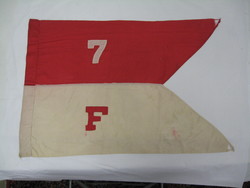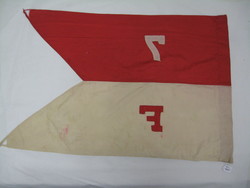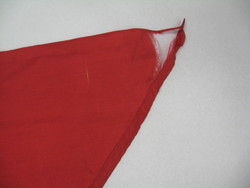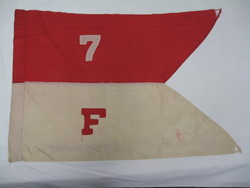U.S. Army Red over White Guidon, Troop F, 7th US Cavalry.
This well worn 27" x 41" silk Cavalry Guidon made in 1885 was flown by Troop F of the 7th United States Cavalry-probably the most storied of all U.S. Cavalry regiments, a fact known by the director John Ford when he chose to depict the 7th in the hair-raising rescue mission against Geronimo's Apaches in his archetypal 1939 film Stagecoach.
In the United States Army a guidon is a flag that a company carries to signify its unit designation and corps affiliation. A basic U.S. Cavalry guidon is rectangular with a wedge-shaped slice cut out, leaving a "swallow-tailed" appearance. The name guidon dates back to the Middle Ages when a company of French dragoons would often use a small flag to guide men or "guide hommes." This became the English "guide upon" and, ultimately, "guidon." When the U.S. Army reauthorized a mounted service in 1833, its guidons followed the design of the pennants made famous by Polish lancers during the Napoleonic Wars: a red upper half above a white lower half. The guidon is a source of both identity and pride for the unit it represents.
The guidon you see is a mute reminder of a unit which was all but annihilated on June 25, 1876 at "Custer's Last Stand." This Battle of the Little Big Horn, though a bitter loss for the U.S. Cavalry, nevertheless represented the beginning of the end of the Plains Indians' way of life. Meanwhile, Troop F went on to long and steadfast service, something that the wear and tear on this guidon well attests.
The 7th became the first Cavalry regiment formed in 1866 after the Civil War as part of the expansion of the regular Army following demobilization of the wartime volunteer and draft units. At first the 7th recruited hard-bitten trappers, frontiersmen, Irish immigrants, international soldiers of fortune, and Civil War veterans from its headquarters at Fort Riley, Kansas. Here the regiment's individual companies received silk Civil War surplus "Stars and Stripes" guidons which the troopers carried as they performed their early postwar duties: assisting Reconstruction efforts in the former Confederate states, monitoring and promoting orderly westward expansion, protecting private and government property, exploring and mapping the frontier, and assimilating the Native American Indian peoples.
In 1867, Lieutenant Colonel George Armstrong Custer organized a regimental band which soon found itself playing an old Irish quickstep called "Garryowen," known to have been a popular drinking song among soldiers in Ireland. According to legend, one of the Irish immigrant soldiers of the 7th who had taken a few drinks sang the tune in Custer's presence. Custer liked its lively beat, which accentuates the cadence of marching horses, and before long the 7th had played the tune so often that it became known as the Garryowen Regiment. In time, "Garryowen" would become what it remains today, the United States Army's most famous regimental march.
In 1867 the 7th was thrown headfirst into confrontation with the Cheyenne, a Great Plains people who actively resisted assimilation by the fast-growing United States. In November of the following year, Custer split the regiment into three columns for a surprise assault on Black Kettle's sleeping village. Within days, Custer's success at this Battle of the Washita River had incited press criticism as "simply an attack upon peaceful bands" and even as a massacre. However, this victory persuaded Custer to divide his force into three battalions-a tactic he would continue to use. The Battle of the Washita River also brought the 7th its reputation as the Army's most capable mounted regiment.
Between 1871 and 1873, the 7th followed the common practice of the time of dispersing its various companies, an act which resulted in service in Mississippi, Kentucky, and the Dakota Territories. However, intense interest by the growing United States in the Dakota Territory-sparked primarily by reports of gold found in the Black Hills-would ultimately focus the efforts of the regiment on the vast area populated by stubbornly independent Plains Indians.
In 1873 the 7th posted to the Dakota Territory's Fort Abraham Lincoln. From there the regiment would conduct the Black Hill Expedition of 1874 in order to scout suitable locations for forts and additional emigrant routes, but also to investigate the reports of gold discoveries. Unfortunately, the Black Hills had been promised to the Native American Indians, who regarded the hills as sacred. Confirmation of the presence of gold soon led to increased Indian hostility and resistance. Furthermore, in 1875 the 7th escorted a railroad survey of the Yellowstone River valley, bringing the regiment into constant conflict with Indian raiding parties.
The Great Sioux War of 1876-77, or the Black Hills War, resulted directly from these confrontations and produced the best known battle of the Indian Wars near the Little Big Horn River in eastern Montana Territory. There Custer once more divided his command into three battalions and personally led one reinforced battalion of five companies, including the forty men of Company F, under Captain George Yates. The regimental band struck up "Garryowen" as Custer rode with his men to their fatal encounter with Lakota and Northern Cheyenne warriors commanded by Sitting Bull. They surrounded and annihilated Custer's outnumbered battalion, leaving all the soldiers of Company F dead on Custer Hill. Adding insult to injury, Congress had failed to approve payment for the Army for 1876, leaving all the Cavalrymen who died at the Little Big Horn died unpaid-for the entire calendar year.
The Army pursued its campaign against the Plains Indians even more relentlessly after Custer's loss. By early 1877 nearly all the tribes who had contributed fighters to the battle were back on their reservations. They would never again band together in such numbers or with such unity. Yet the 7th quickly found a new enemy in Chief Joseph of the Nez Perce Indians, over whom they finally gained victory at the Battle of the Bears Paw Mountains in Montana in October 1877.
Defeat of the Plains Indians resulted in a decade of relative calm for the 7th at their garrison at Fort Abraham Lincoln, although the Cavalry did experience some changes during this period. Its 27" x 41" silk guidons, which had evolved from the red over white pattern of 1833 to the stars and stripes design introduced in 1862, went back again to red over white in 1885. Meanwhile, in 1883 the Army had redesignated its Cavalry companies as troops.
During its posting from 1888 to 1892 at Fort Riley, Kansas the 7th would take part in the Battle of Wounded Knee-known to many of its critics as the Wounded Knee Massacre. In November 1890, soldiers from the 7th traveled by rail from Fort Riley to Wounded Knee, where they joined the 6th, 8th, and 9th Cavalry regiments to pursue a band of Sioux Indians, many of whom belonged to the mystic Ghost Dance movement which was prophesied by some of its followers to empty the Great Plains of white settlers and to restore the buffalo herds.
On December 29, the Sioux leader Big Foot and several hundred of his people were camped along the banks of Wounded Knee Creek. As U.S. soldiers who had surrounded the camp moved to disarm Big Foot and his warriors, a shot rang out and chaos erupted. From the heights above the Indian camp, the soldiers fired not only at Big Foot's armed men, but indiscriminately at teepees holding dozens of women and children.
Perhaps three hundred Sioux died at Wounded Knee, along with twenty-five U.S. soldiers. The battle-or massacre-crushed the Ghost Dance movement, ended the Indian Wars, and, for many soldiers of the 7th and large numbers of other Americans, constituted the final revenge for Custer's defeat at the Little Big Horn.
Far less memorably or tragically, 1890 also saw the Cavalry begin issuing its 27" x 41" red over white guidon in wool bunting to replace for everyday use the less durable silk guidons like the one you see here. The 7th Cavalry's F Troop would carry a rugged wool guidon over much of the globe during the next forty-one years.
During the late 1890s, the regiment used Fort Bayard in the New Mexico Territory and Forts Grant and Huachuca in the Arizona Territory as bases for pursuit of scattered bands of Indian raiders, sometimes into Mexico. Young Edgar Rice Burroughs, who would go on to fame as creator the Tarzan books, served briefly with the 7th at Fort Grant until his discharge from the Army because of a heart problem.
The 7th traveled to Cuba only after the end of the Spanish-American War for occupation duty, returning to the United States in 1902 for two years of garrison duty and maneuvers at Camp George H. Thomas in Georgia. Then, in 1904 the 7th arrived in the Philippine Islands, recently acquired from Spain by victory in the Spanish-American War. From their garrison at Camp McGrath in Batangas Province, on the southern part of the main island of Luzon, Troop F ventured out for counterinsurgency missions against a pro-independence force known as the Irreconcilables, and who were protected as heroes and patriots by much of the native population.
Troop F returned with the rest of the 7th to Fort Riley, Kansas, in 1907, but went back to the Philippines, to Fort William McKinley on the outskirts of Manila, for garrison duty lasting until 1915. The United States would successfully deny Filipino independence until the signing of the Treaty of Manila on July 4, 1946, a monument to the first big wave of the post-WWII emergence of new independent nations.
After returning home the 7th patrolled the U.S.-Mexico border from their base at Camp Harvey J. Jones in Arizona and, in 1916 and 1917, assisted the punitive Mexican Expedition against Pancho Villa. The speed with which the First World War ended after entry of the United States prevented the regiment from serving in the war in Europe and they remained stationed at Fort Bliss in Texas the entire time, continuing patrol along the border with Mexico.
In 1921 the Army eliminated silk guidons for all purposes in favor of the more durable wool bunting service version, which now began appearing even in parade displays. This ended the tradition of using silk guidons by U.S. mounted troops, one which began nearly a century earlier in 1833.
During the Great Depression the 7th supported the Civilian Conservation Corps, a public work relief program-organized along military lines-for unemployed men between eighteen and twenty-four years old. Still at Fort Bliss, the 7th remained the last bastion of horse-mounted cavalry. Here the fabled WWII tank commander Creighton Abrams got his start, distinguishing himself as F Troop's finest lieutenant before heading off for his future in armored missions.
Finally dismounted and reorganized as an infantry-cavalry hybrid in 1943, the 7th journeyed to Australia for combat in the Pacific Theater where it fought in General Douglas MacArthur's island-hopping campaigns from the Admiralty Islands to New Guinea and the Philippines. In January 1945 the regiment saw action as part of a "Flying Column" that covered over a hundred miles in sixty-six hours, penetrating deep into Luzon and freeing almost four thousand prisoners. Eventually they would return to Batangas Province, the scene of their duty from 1904 to 1907.
At the end of the war the 7th provided some of the first troops to enter Tokyo in the occupying army, with the regiment's 2nd Battalion acting as the honor guard for Army General MacArthur as he took up residence. From Japan the 7th moved on to the Korean War, using the services of Lieutenant Colonel Brice Custer, nephew of George Armstrong Custer. Reorganized by this time as infantry despite retaining its cavalry designation, the 7th fought in some of the Korean War's deadliest battles.
The 7th reorganized again for the Vietnam War, moving beyond traditional on-foot infantry missions to helicopter assaults as an airmobile infantry. From their massive firebase in the Central Highlands, the soldiers of the 7th fought in the Ia Drang Valley in November 1965 in the first major battle between the United States Army and the People's Army of Vietnam, referred to by U.S. fighting units as the North Vietnamese Army or NVA. The role of the First and Second Battalions of the 7th in the Battle of Ia Drang would be described in a 1992 book, We Were Soldiers Once. . . And Young, by retired Lieutenant General Harold G. Moore and war journalist Joseph Galloway. The 2002 film We Were Soldiers, starring Mel Gibson, dramatized the story told by Moore and Galloway for the screen.
After the Vietnam War, the 7th went to Fort Hood in Texas where it became part of the TRICAP experiment to constitute an army division as one armored brigade, one light infantry brigade, and one aviation brigade. In the 1980s the regiment traded in its M60 Patton tanks, named after the great General George S. Patton, for the M1A1 Abrams tank bearing the name of the 7th Cavalry's own legend, Creighton Abrams.
During the 1990 and 1991 Gulf War to liberate Kuwait, the 7th conducted information-gathering and security operations and ultimately deployed its 1st battalion as the first unit to engage the Iraqi enemy. Over the past two decades the 7th has supported the United Nations peacekeeping mission in Bosnia and screened U. S. military operations against interference by hostile forces in Kosovo. Today the 7th remains extremely active in Iraq.
The Battle of the Little Big Horn of 1876 had a paradoxical effect on Troop F of the 7th United States Cavalry, at once nearly erasing it from the pages of history while enshrining its presence forever on those pages. Subsequent battles by the 7th-consider Wounded Knee or of the Philippines, Vietnam, or Iraq-remind us that Americans will sometimes applaud and sometimes abhor the actions of their military men and women. Perhaps the violence of war guarantees violently opposed reactions. Whatever view one takes of the application of military force by the United States, one cannot adequately recount American history without allusion to the military in general or to the 7th Cavalry in particular. The contemporary violence in Iraq and Afghanistan underscores this point.
Custer had his Last Stand but the 7th did not and, in a violent world, might not for a very long time. Nor, if it is respected as the survivor of a history whose meaning Americans will continue to dispute, will this old silk guidon have its Last Stand for a very long time.
Exhibition History:
Private Exhibition
Washington Flag Congress, 2011
24th International Congress of Vexillology and
45th annual meeting of the North American Vexillological Association.
Washington, DC & Alexandria, VA
July 31-August 6, 2011
ZFC Significant Flag
Provenance:
• Troop F, 7th U.S. Cavalry, 1890 - circa1900
• Acquired by Thomas F. Aldon Collection, until passing in 2009.
• Sold via Cowan's of Cincinnati, Ohio to Zaricor Flag Collection, 2010
Sources:
Quartermaster General US Army, U.S. Army Uniforms and Equipment, 1889, reprint, University of Nebraska Press, Lincoln, 1986.
7th Cavalry Regiment (United States), Wikipedia, 12 November 2011, from: http://en.wikipedia.org/wiki/7th_Cavalry_Regiment_%28United_States%29
7th U.S. Cavalry Association, 12 November 2011, from:
http://www.us7thcavalry.com/
History of the 7th Cavalry Regiment, 12 November 2011, from: http://lewis184.home.mchsi.com/7th_cavalry_regiment.htm
Image Credits:
Zaricor Flag Collection































